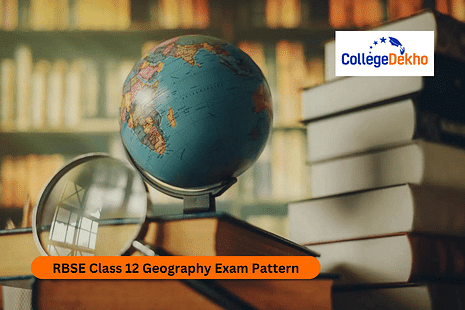

Never Miss an Exam Update
RBSE Class 12 Geography Exam Pattern 2025:
The Rajasthan Board of Secondary Education (RBSE) prescribes the RBSE Board 12th Geography blueprint 2025 for the students preparing for the RBSE Class 12 exam. A 100-mark exam, wherein 70 marks will be based on the theory exam, and 30 marks will be allotted for the practical/experimental exam. Again, the 70 marks theory paper will be divided into 56 marks (score for question paper) and 14 marks (semester record, and verbal). The 30 marks practical paper will also be bifurcated into a 15 marks question paper and 15 marks semester record, and verbal. The
RBSE Class 12 Geography syllabus 2025
covers two parts, Part 1 Fundamentals of Human Geography, and Part 2 India: People and Economy. These two parts further consist of units, where Part 1 includes 3 units, and Part 2 has 5 units. Both parts will carry 28 marks in the exam. In Part 1, unit 3 will have the highest marks weightage of 18, also in Part 2, unit 3 will carry the maximum weightage of 14 marks in the class 12th board exam. The RBSE Class 12 Geography question paper will comprise MCQs, very short answer type, short answer type, and long answer type questions.
Moreover, the
RBSE class 12 time table 2025
will be released tentatively in January 2025, and the exams are to be conducted in February–April 2025. Continue reading the article to learn more about the RBSE Class 12 Geography Exam Pattern 2025.
RBSE Class 12 Geography Exam Pattern 2025
There will be two question papers for the students who are appearing for the RBSE Class 12 Geography Exam– theory and practical. The marking scheme of the RBSE Class 12 Geography Exam 2025 is as follows:
| Question paper | Time (hours) | Score for question paper | Semester / Record and Verbal | Marks |
|---|---|---|---|---|
| Theoretical | 3:15 | 56 | 14 | 70 |
| Practical | 4:00 | 15 | 15 | 30 |
Part 1: Fundamentals of Human Geography - 28 Marks
| Units | Chapters | Topics | Marks |
|---|---|---|---|
| Unit I | Chapter 1 Human Geography - Nature and Scope | Nature of Human Geography, Definitions of Human Geography, Naturalization of Human and Humanization of Nature. | 03 |
| Unit II | Chapter 2 The World Population: Distribution, Density and Growth | Patterns of population distribution in the world, density of population, factors influencing the distribution of Population growth, components of population change-births, deaths and migration, demographic transition, population control measures. | 05 |
| Chapter 3 Human Development | Growth and development, The four pillars of Human development, Approaches to human, development. measuring human development. The human development index (HDI). International comparisons. | ||
| Unit III | Chapter 4 Primary activities | Hunting and gathering, Pastoralism: Nomadic herding, Commercial livestock rearing. Agriculture. intensive subsistence agriculture. plantation agriculture. Extensive Commercial grain cultivation. Mixed farming. Dairy farming. Mediterranean agriculture. Market gardening and Horticulture. co-operative farming. | 18 |
| Chapter 5 Secondary activities | Manufacturing, Characteristics of modern large scale manufacturing. Skill specialization, mechanization, organizational structure and stratification. Technological innovation. Uneven geographical distribution, Access to market. Access to raw material Access, access to labour Rajasthanply, access to Sources of Energy. | ||
| Chapter 6 Tertiary and Quaternary Activities | Types of tertiary activities, trade and commerce, retail trading, wholesale trading, transport, communication, telecommunication, services, people engaged in tertiary activities, some selected examples —tourism, tourism region, Medical services for overseas patients in India- medical tourism, quaternary activities. | ||
| Chapter 7 Transport & Communication | Land Transport- Roads, Border roads, railways- trans-continental railways, the orient express. water transport- sea routes. Shipping canals- the Suez Canal, the Panama Canal. Inland waterways. Air transport. | ||
| Chapter 8 International Trade | History of international trade, why international trade existed, basis of international trade, Volume of Trade, Composition of Trade, direction of trade, balance of trade, free trade situation, dumping, world trade organization, matters related to international trade, port, type of port. | ||
| Map work will be based on the units given above in the given Outline map of the world | 02 |
Part 2: India: People and Economy - 28 Marks
Units | Chapters | Topics | Marks |
|---|---|---|---|
Unit I | Chapter 1 Population: Distribution of Density, Growth and Composition | Distribution of density of population, Growth of Population,regional variations in population growth, population composition - rural-urban composition, linguistic composition and linguistic classification, religious composition, composition of working population. OccRajasthanatiolnal Categories. | 03 |
Unit II | Chapter 2 Human Settlements | Rural settlements, Types of Rural Settlement. the basic differences between rural and urban settlements, types of rural settlements. urban settlements: Ancient Towns, Medieval Towns and Modern Town. Urbanisation in India Functional Classification of Towns, Smart cities Mission. | 02 |
Unit III | Chapter 3 Land Resources And Agriculture | Land Use Categories, Land Use Change In India, Common Property Resources, Agricultural Land Use In India, Cropping Seasons In India, Types Of Farming, Foodgrains: Rice, Wheat, Jowar Maize, Bajra, Pulses, Gram, Tur (Arhar) Fibrous Crops: Cotton And Jute. | 14 |
Chapter 4 Water Resources | Water resources of India water demand and utilization, water quality depletion, water conservation and management, water pollution prevention, water recycling and reuse, watershed management, rainwater harvesting, watershed development: a reality Study, Indian National Water Policy, 2002, Jal Kranti Abhiyan (2015 -16). | ||
Chapter 5 Mineral and Energy Resources | Types of Mineral Resources, Distribution of Minerals in India: Ferrous Mineral: Iron-Ore, Copper, Bauxite, Manganese Non-ferrous Minerals. Non-metallic Minerals Energy Resources. | ||
Chapter 6 Planning And Sustainable Development In Indian Context | Types of Mineral Resources, Distribution of Minerals in India: Ferrous Mineral: Iron-Ore, Copper, Bauxite, Manganese Non-ferrous Minerals. Non-metallic Minerals Energy Resources | ||
Unit IV | Chapter 7 Transport and Communication | Major means of transport, Oil & Gas Pipeline, Communication Network. | 04 |
Chapter 8 International Trade | Changing Pattern of the Composion of Indias Exports, Changing Pattern of the Composion of Indias Import. | ||
Unit V | Chapter 9 Geographical Perspective on Selected Issues and Problems | Environmental pollution, Urban Waste Disposal Case Study. | 03 |
Map work will be based on the units given above in the given Outline map of the world | 02 |
Also read: RBSE Class 12 Geography Model Paper 2025
RBSE Class 12 Geography Practical Blueprint 2025
The RBSE Class 12 Geography Practical Exam will be held for 16 marks. There will be a total of 4 questions from Chapters 1, 2, 3, and 4, and each question is worth 4 marks. All questions are compulsory. Read More RBSE Class 12 Exam Pattern 2025
- Chapter 1 Data: sources and compilation
- Chapter 2 Data processing
- Chapter 3 Graphical representation of data
- Chapter 4 Spatial information technology
| Particulars | Marks |
|---|---|
| Practical Record | 10 Marks |
| Viva Voice | 4 Marks |
Practical Work in Geography II is NCERT's Book Published under Copyright. The prescribed books for RBSE Class 12 Geography Practical Exam are:
- Geography (Arts Category) Geography (14)
- Board of Secondary Education Rajasthan, Ajmer
RBSE Class 12 Geography Question Paper Pattern 2025
Students will have 3 hours and 15 minutes to complete the RBSE 12th Geography question paper. A total of 22 questions will be on the RBSE Class 12 Geography exam 2025. The question paper pattern of RBSE 12th Geography exam is tabulated below:| Sections | Question No. | Type of Questions | Marks |
|---|---|---|---|
| Section A |
Question no. 1
Question no. 2 Question no. 3 |
MCQs - 9
Fill in the blanks - 4 Very short answer type questions - 4 | 17 |
| Section B | Question no. 4 to 15 | Short answer type questions | 18 |
| Section C | Question no. 16 to 18 | Long answer type questions | 9 |
| Section D | Question no. 18 to 20 | Essay type questions | 8 |
| Section E | Question no. 21 to 22 | Map pointing | 4 |
Students are advised to go through each section on this page and prepare well for the class 12th Geography exam to score incredible marks in RBSE 12th Result 2025 .
FAQs
Was this article helpful?






















